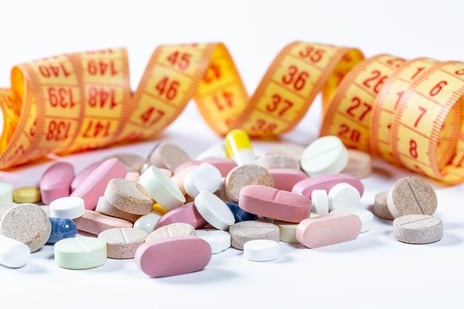Aim of the study
SURMOUNT-1 [1] evaluated the efficacy and safety of tirzepatide in adults with obesity or overweight without diabetes.

Background
Tirzepatide is a novel dual glucose-dependent insulinotropic peptide (GIP) and glucagon-like peptide-1 receptor agonist (GLP-1 RA). As first-in-class medication, tirzepatide (Mounjaro®, Eli Lilly) was approved in May 2022 in the United States for the treatment of type 2 diabetes as adjunct to diet and exercise. A marketing authorization application to the European Medicines Agency (EMA) was submitted as announced in a news release at the end of last year - with a decision still pending.
The combined GLP-1 and GIP receptor activation has been examined recently as a promising therapeutic concept, given that the two incretins can act on pancreatic beta cells both synergistically and complementarily through distinct metabolic effects [2]. In addition, GIP has beneficial effects beside its incretin role by improving insulin sensitivity and lipid homeostasis in adipose tissue [3].
Tirzepatide is formulated as a synthetic linear peptide containing 39 amino acids, based on the native GIP sequence. It is attached to a 20-carbon fatty diacid moiety, which binds to albumin, prolonging its half-life to five days and thus enabling once-weekly dosing. Preclinical data demonstrated that the affinity of tirzepatide for GIP receptors was equal to the affinity of native GIP for GIP receptors, whereas tirzepatide bound GLP-1 receptors with affinity approximately five times weaker than native GLP-1 bound GLP-1 receptors [4].
In phase 2 studies in type 2 diabetic patients, tirzepatide induced clinically meaningful weight reduction, which is why the administration in patients with obesity could also be worthwhile [5].
Methods
This was a phase 3, double-blind, randomized, controlled trial with 2539 adults (at 119 sites in 9 countries) with a body mass index of 30 or more, or 27 or more and at least one weight-related complication, excluding diabetes. Treatment randomization was stratified by country, sex, and the presence or absence of prediabetes.
Study participants received once-weekly subcutaneous tirzepatide (5 mg, 10 mg or 15 mg) or placebo in a 1:1:1:1 ratio – for 72 weeks, including a 20-week dose escalation period.
Tirzepatide was initiated at a dose of 2.5 mg once weekly (or matching placebo) and was increased by 2.5 mg every 4 weeks during the dose-escalation period to reach a maintenance dose of up to 15 mg once weekly by week 20.
Participants underwent lifestyle interventions such as regular lifestyle counseling sessions given by a dietician, to help to adhere to a balanced healthy diet and achieve a daily deficit of 500 kcal.
After 72 weeks of treatment, subjects who had no prediabetes at randomization proceeded to a 4-week safety follow-up period; those with prediabetes continued in their treatment group for an additional 2-year period (these data were not reported in the article).
Endpoints
Coprimary endpoints were the percentage change in weight from baseline and a weight reduction of 5% or more.
Key secondary endpoints included weight reduction of 10% or more, 15% or more, and 20% or more; change in waist circumference, systolic blood pressure, fasting insulin, and lipid levels. In a subgroup of 255 participants, the percentage of total body-fat mass was assessed with dual-energy x-ray absorptiometry.
Results
From the 2539 participants, 86.0% completed the primary trial treatment period (88.4% to 89.8% across the tirzepatide groups and 77.0% in the placebo group) and 81.9% adhered to the treatment or placebo as assigned (83.5% to 85.7% across the tirzepatide groups and 73.6% in the placebo group). Treatment discontinuations due to adverse events were 4.3%, 7.1%, and 6.2% with 5 mg, 10 mg, and 15 mg of tirzepatide, respectively, compared to 2.6% with placebo.
Demographic data were comparable between treatment groups with a mean age of 44.9 years, most females (67.5%) and White (70.6%), mean body weight of 104.8 kg, BMI of 38.0 and the mean waist circumference was 114.1 cm. The average duration of obesity (in case of a BMI higher than 30, which was present in 94.5% of all participants) was 14.4 years. 40.6% had prediabetes at baseline and nearly two thirds had one or more weight-related complications.
Body weight
The mean percentage change in weight at week 72 was -15.0% (95% confidence interval (CI), -15.9 to -14.2) with 5 mg weekly tirzepatide, -19.5% (95% CI, -20.4 to -18.5) with 10 mg, and -20.9% (95% CI, -21.8 to -19.9) with 15 mg and -3.1% (95% CI, -4.3 to -1.9%) with placebo. The effect of all treatments were highly significant in comparison to placebo (P<0.001). A weight reduction of 5% or more was shown in 85%, 89% and 91% of subjects with 5 mg, 10 mg and 15mg, respectively, and 35% with placebo; 50% and 57% percent of participants in the 10 mg and 15 mg group had a weight reduction of 20% or more, in comparison to 3% in the placebo group.
Cardiometabolic risk factors
Improvements were noted with regard to a reduction in waist circumference (-14.0, -17.7, -18.5 cm with ascending tirzepatide doses, -4.0 cm in the placebo group), as well as both systolic and diastolic blood pressure, fasting insulin and lipid levels [1]. At week 72, 95.3% of the participants with prediabetes returned to normoglycemic values (in comparison to 61.9% in the placebo group).
Body composition
In the subgroup of participants undergoing dual-energy x-ray absorptiometry (efficacy estimand including 160 of the 255 participants in the subgroup with evaluable results at baseline and week 72) the mean reduction in body fat was 33.9% with tirzepatide and 8.2% with placebo.
Safety
Of all participants treated with tirzepatide 78.9 to 81.8% of subjects had at least one adverse event – in comparison to 72.0% in the placebo group. The most frequent adverse events were related to the gastrointestinal tract including nausea, diarrhea, and constipation. They were reported with mainly mild to moderate severity and with an occurrence predominantly in the escalation phase.
In about 6% of participants (n=160) serious adverse events were reported; with a similar rate in the tirzepatide and placebo group.
Cholecystitis and acute cholecystitis were reported more frequently among the tirzepatide groups than in the placebo group, even though the incidences were low (<=0.6%).

Conclusion and Discussion
With an average body weight reduction of placebo-adjusted 16.4% and 17.8% in the 10 mg and 15 mg treatment dose groups, tirzepatide led to an unusually high substantial degree of weight loss. This weight loss is possible due to the additive effect of targeting multiple hormone pathways involved in energy homeostasis, namely GLP-1 and GIP receptor pathways.
The observed weight loss is higher than with all other obesity medications currently on the market. For comparison, the average placebo-adjusted weight loss with older anti-obesity medication is approximately 3.0 to 8.6% [6]. The recently approved anti-obesity medication semaglutide (2.4 mg), showed a placebo-adjusted weight reduction of 12.4% [7]. Bariatric surgery however, can lead to weight reduction of approximately 25-30% within 1-2 years [8, 9]. In the current trial of Jastreboff et al. [1], 36.2% of participants in the 15 mg tirzepatide group met the exploratory endpoint of a weight reduction of 25% or more.
Furthermore, tirzepatide led to changes in body composition – the amount of fat-mass loss exceeded that of the lean-mass by three times. The ratio of fat-mass loss to lean-mass loss was comparable to that of surgical and lifestyle-based treatments of obesity [10].
With regard to safety, cholecystitis was observed more frequently in the tirzepatide group, although the incidences were low (<=0.6%), which complicates the evaluation about a causal relationship. However, gallbladder-related events were reported with regard to other obesity therapies like bariatric surgery or treatment with GLP-1 RAs.
To conclude, tirzepatide – beside its positive effects on cardiovascular risk parameters, the change in body composition and an overall acceptable safety profile – led to a substantial weight loss among all three doses given and could, therefore, have a meaningful impact in the treatment of obesity in the future.
Read more about our expertise in testing medical technology: Insulin pump development and design, artificial pancreas study and the AP@home project, glucose monitoring.




